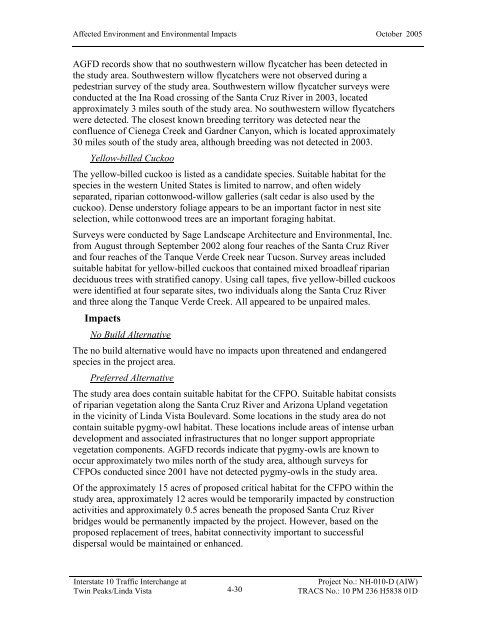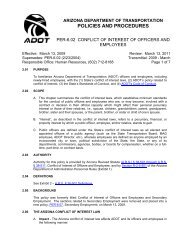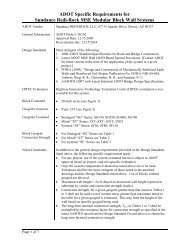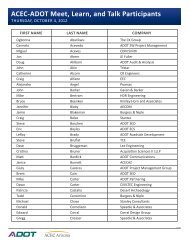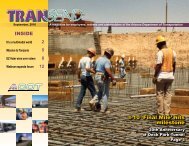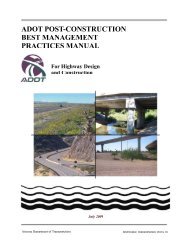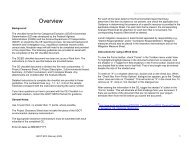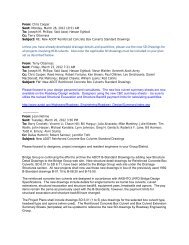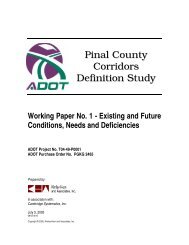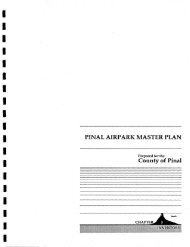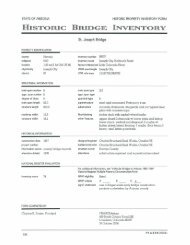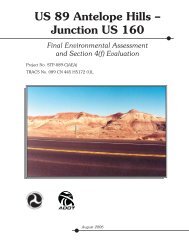I-10 Twin Peaks Traffic Interchange, Environmental Assessment
I-10 Twin Peaks Traffic Interchange, Environmental Assessment
I-10 Twin Peaks Traffic Interchange, Environmental Assessment
You also want an ePaper? Increase the reach of your titles
YUMPU automatically turns print PDFs into web optimized ePapers that Google loves.
Affected Environment and <strong>Environmental</strong> Impacts October 2005<br />
AGFD records show that no southwestern willow flycatcher has been detected in<br />
the study area. Southwestern willow flycatchers were not observed during a<br />
pedestrian survey of the study area. Southwestern willow flycatcher surveys were<br />
conducted at the Ina Road crossing of the Santa Cruz River in 2003, located<br />
approximately 3 miles south of the study area. No southwestern willow flycatchers<br />
were detected. The closest known breeding territory was detected near the<br />
confluence of Cienega Creek and Gardner Canyon, which is located approximately<br />
30 miles south of the study area, although breeding was not detected in 2003.<br />
Yellow-billed Cuckoo<br />
The yellow-billed cuckoo is listed as a candidate species. Suitable habitat for the<br />
species in the western United States is limited to narrow, and often widely<br />
separated, riparian cottonwood-willow galleries (salt cedar is also used by the<br />
cuckoo). Dense understory foliage appears to be an important factor in nest site<br />
selection, while cottonwood trees are an important foraging habitat.<br />
Surveys were conducted by Sage Landscape Architecture and <strong>Environmental</strong>, Inc.<br />
from August through September 2002 along four reaches of the Santa Cruz River<br />
and four reaches of the Tanque Verde Creek near Tucson. Survey areas included<br />
suitable habitat for yellow-billed cuckoos that contained mixed broadleaf riparian<br />
deciduous trees with stratified canopy. Using call tapes, five yellow-billed cuckoos<br />
were identified at four separate sites, two individuals along the Santa Cruz River<br />
and three along the Tanque Verde Creek. All appeared to be unpaired males.<br />
Impacts<br />
No Build Alternative<br />
The no build alternative would have no impacts upon threatened and endangered<br />
species in the project area.<br />
Preferred Alternative<br />
The study area does contain suitable habitat for the CFPO. Suitable habitat consists<br />
of riparian vegetation along the Santa Cruz River and Arizona Upland vegetation<br />
in the vicinity of Linda Vista Boulevard. Some locations in the study area do not<br />
contain suitable pygmy-owl habitat. These locations include areas of intense urban<br />
development and associated infrastructures that no longer support appropriate<br />
vegetation components. AGFD records indicate that pygmy-owls are known to<br />
occur approximately two miles north of the study area, although surveys for<br />
CFPOs conducted since 2001 have not detected pygmy-owls in the study area.<br />
Of the approximately 15 acres of proposed critical habitat for the CFPO within the<br />
study area, approximately 12 acres would be temporarily impacted by construction<br />
activities and approximately 0.5 acres beneath the proposed Santa Cruz River<br />
bridges would be permanently impacted by the project. However, based on the<br />
proposed replacement of trees, habitat connectivity important to successful<br />
dispersal would be maintained or enhanced.<br />
Interstate <strong>10</strong> <strong>Traffic</strong> <strong>Interchange</strong> at<br />
<strong>Twin</strong> <strong>Peaks</strong>/Linda Vista<br />
4-30<br />
Project No.: NH-0<strong>10</strong>-D (AIW)<br />
TRACS No.: <strong>10</strong> PM 236 H5838 01D


